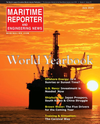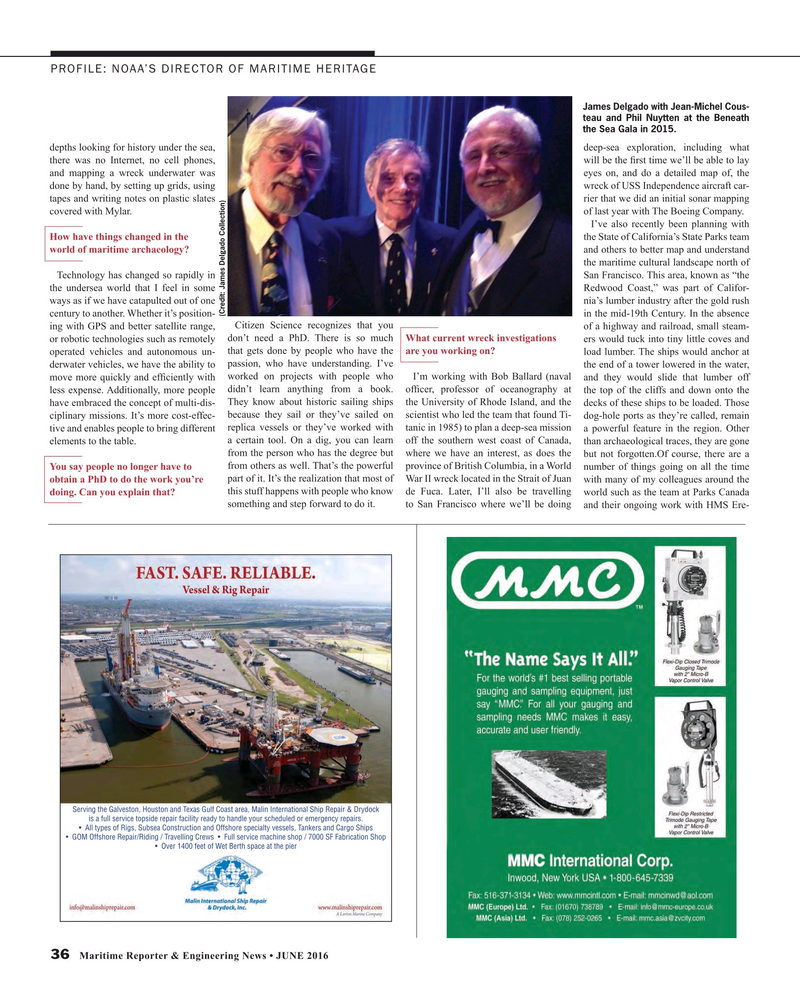
Page 36: of Maritime Reporter Magazine (June 2016)
Annual World Yearbook
Read this page in Pdf, Flash or Html5 edition of June 2016 Maritime Reporter Magazine
PROFILE: NOAA’S DIRECTOR OF MARITIME HERITAGE
James Delgado with Jean-Michel Cous- teau and Phil Nuytten at the Beneath the Sea Gala in 2015.
depths looking for history under the sea, deep-sea exploration, including what there was no Internet, no cell phones, will be the ? rst time we’ll be able to lay and mapping a wreck underwater was eyes on, and do a detailed map of, the done by hand, by setting up grids, using wreck of USS Independence aircraft car- tapes and writing notes on plastic slates rier that we did an initial sonar mapping covered with Mylar. of last year with The Boeing Company.
I’ve also recently been planning with
How have things changed in the the State of California’s State Parks team world of maritime archaeology? and others to better map and understand the maritime cultural landscape north of
Technology has changed so rapidly in San Francisco. This area, known as “the the undersea world that I feel in some Redwood Coast,” was part of Califor- ways as if we have catapulted out of one nia’s lumber industry after the gold rush (Credit: James Delgado Collection) century to another. Whether it’s position- in the mid-19th Century. In the absence ing with GPS and better satellite range, Citizen Science recognizes that you of a highway and railroad, small steam- or robotic technologies such as remotely don’t need a PhD. There is so much What current wreck investigations ers would tuck into tiny little coves and operated vehicles and autonomous un- that gets done by people who have the are you working on? load lumber. The ships would anchor at derwater vehicles, we have the ability to passion, who have understanding. I’ve the end of a tower lowered in the water, move more quickly and ef? ciently with worked on projects with people who I’m working with Bob Ballard (naval and they would slide that lumber off less expense. Additionally, more people didn’t learn anything from a book. of? cer, professor of oceanography at the top of the cliffs and down onto the have embraced the concept of multi-dis- They know about historic sailing ships the University of Rhode Island, and the decks of these ships to be loaded. Those ciplinary missions. It’s more cost-effec- because they sail or they’ve sailed on scientist who led the team that found Ti- dog-hole ports as they’re called, remain tive and enables people to bring different replica vessels or they’ve worked with tanic in 1985) to plan a deep-sea mission a powerful feature in the region. Other elements to the table. a certain tool. On a dig, you can learn off the southern west coast of Canada, than archaeological traces, they are gone from the person who has the degree but where we have an interest, as does the but not forgotten.Of course, there are a
You say people no longer have to from others as well. That’s the powerful province of British Columbia, in a World number of things going on all the time obtain a PhD to do the work you’re part of it. It’s the realization that most of War II wreck located in the Strait of Juan with many of my colleagues around the doing. Can you explain that? this stuff happens with people who know de Fuca. Later, I’ll also be travelling world such as the team at Parks Canada something and step forward to do it. to San Francisco where we’ll be doing and their ongoing work with HMS Ere-
Serving the Galveston, Houston and Texas Gulf Coast area, Malin International Ship Repair & Drydock is a full service topside repair facility ready to handle your scheduled or emergency repairs. s

 35
35

 37
37
